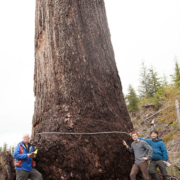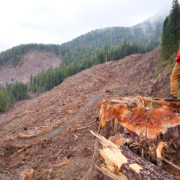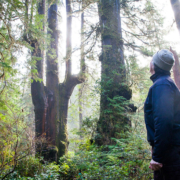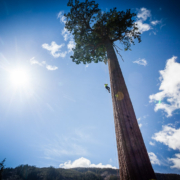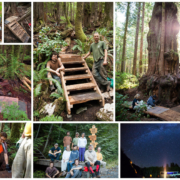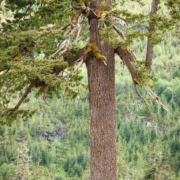Avatar Grove Boardwalk damaged by windstorm – Completion launch delayed until Spring
For Immediate Release
October 28, 2016
Avatar Grove Boardwalk – Winter Storm Damage Delays Completion Launch of Big Tree Showcase Trail until the Spring.
Lower Grove closed until trail clearing and boardwalk repairs can be done, while the Upper Grove remains open to visitors.
Port Renfrew – Damage to the famed Avatar Grove Boardwalk in the Lower Grove due to the hurricane-force winds during the October 15 storm has delayed the completion launch of the Avatar Grove Boardwalk until next spring. The Ancient Forest Alliance had literally just completed the boardwalk a week before the storm, after 3 years of hard work involving a hundred volunteers, and was about to hold a ribbon-cutting ceremony last week to announce its completion – but now the launch will be delayed until the boardwalk can be repaired and the trail cleared, which will take several months due to the wet winter weather. The winter storm resulted in at least 30 trees crashing down over the Avatar Grove Trail in the Lower Grove, damaging sections of the boardwalk. Luckily none of the grove’s famed giant redcedars or Douglas-firs fell during the storm.
The entrance to the Lower Avatar Grove has since been cordoned off for the time being, while the Upper Avatar Grove boardwalk remains open and in decent condition.
Note: For safety reasons the Ancient Forest Alliance asks that members of the public do not attempt to clear the fallen trees on their own. The trail clearing will be undertaken by a team of professional arborists who are trained and certified to undertake such operations.
“After anticipating the launch of the boardwalk’s completion after three years of hard work, this is undoubtedly a bit of a disappointment and setback – but it’s only temporary. We’ll get back to work to clear the trail and fix the boardwalk damage over the ensuing months, and launch the boardwalk in the spring. We’re most grateful for the large community of Avatar Boardwalk supporters and volunteers who’ve taken this project so far and who I know will help get this project back on track to completion”, stated TJ Watt, the Ancient Forest Alliance’s photographer and coordinator of the Avatar Grove Boardwalk project. “Avatar Grove has already become a core attraction for visitors from around the world to visit Port Renfrew and Vancouver Island, and the boardwalk’s completion will only enhance its place as one of the great places in Canada to see.”
A 20 minute drive from Port Renfrew, the Avatar Grove (a popular nickname for its Nuu-cha-nulth Pacheedaht name of “T’l’oqwxwat”) is one of the most spectacular and easily accessible stands of monumental old-growth trees in British Columbia, protected in 2012 after an intense campaign led by the Ancient Forest Alliance in conjunction with the Port Renfrew Chamber of Commerce. Thousands of tourists from around the world now come to visit the Avatar Grove, hugely bolstering the regional economy with Tall Tree Tourism.
The Ancient Forest Alliance began construction of the Avatar Grove Boardwalk in 2013 to protect the tree roots and understory vegetation from excessive trampling, enhance visitor access and safety, and support the local eco-tourism economy.
This last reason for the boardwalk – to support the local eco-tourism economy in Port Renfrew and beyond – has had a significance far beyond Avatar Grove, acting as a “catalyst” to help to shape the fate of endangered old-growth forests across BC. Driven by Avatar Grove’s economic significance, various Chambers of Commerce – starting with the Port Renfrew Chamber of Commerce in late 2015, followed by the Sooke and Westshore Chambers of Commerce, and culminating in May with the BC Chamber of Commerce, the province’s premier business lobby representing 36,000 businesses – have called on the province to increase the protection of BC’s old-growth forests to support the economy. Similarly, the Union of BC Municipalities (UBCM), representing local city, town, and regional district councils across BC, passed a resolution in September calling on the province to amend the outdated 1994 Vancouver Island Land Use Plan to protect the Island’s remaining old-growth forests.
“The Avatar Grove Boardwalk’s real significance is to serve as an example for other communities that protecting old-growth forests is good for the economy, hugely supporting local businesses and jobs. In helping to revitalize Port Renfrew’s economy, it clearly counteracts the old, false narrative that protecting old-growth forests harms rural economies”, stated Ken Wu, the Ancient Forest Alliance’s executive director. “The Avatar Grove has been the most important catalyst in the movement to BC’s endangered old-growth forests in recent times”.
The Avatar Grove Boardwalk has been supported by the Port Renfrew Chamber of Commerce, Mountain Equipment Co-op, Sitka clothing, the Habitat Conservation Trust Foundation, Recreation Sites and Trails BC, and the Pacheedaht First Nation who provided much of the wood.
More Background Info
The catalyst for much of the momentum for protecting old-growth forests on Vancouver Island in recent years has been the small community of Port Renfrew, formerly a logging town, which has been transformed in recent years into a big tree tourism destination (dubbed the “Tall Trees Capital of Canada”) as hundreds of thousands of tourists have come from around the world to visit some of Canada’s largest trees in the nearby Avatar Grove, Big Lonely Doug (Canada’s 2nd largest Douglas-fir tree), the Red Creek Fir (the world’s largest Douglas-fir tree), San Juan Spruce (until recently Canada’s largest Sitka spruce tree – its top broke off in a recent storm unfortunately), the Harris Creek spruce (one of the largest Sitka spruce trees in Canada), and the endangered, magnificent Central Walbran Valley. The Ancient Forest Alliance has been working with the local Chamber of Commerce for years to protect the old-growth forests in the area and to complete the Avatar Grove Boardwalk.
• The Ancient Forest Alliance calling on the BC government to implement a comprehensive science-based plan to protect all of BC’s remaining endangered old-growth forests, and to also ensure a sustainable, value-added second-growth forest industry.
• Old-growth forests are vital to sustain endangered species, climate stability, tourism, clean water, wild salmon, and the cultures of many First Nations.
• On BC’s southern coast, satellite photos show that at least 75% of the original, productive old-growth forests have been logged, including well over 90% of the valley bottoms where the largest trees grow. See maps and stats on the remaining old-growth forests on BC’s southern coast at: www.ancientforestalliance.org/old-growth-maps.php

